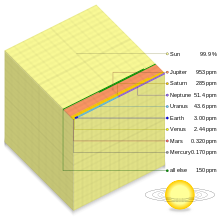
Back قائمة أجرام المجموعة الشمسية مرتبة حسب الحجم Arabic Listn vo de massnreichstn Keapan im Sunsystem BAR Спіс аб’ектаў Сонечнай сістэмы па памерах Byelorussian Списък на обектите в Слънчевата система по радиус Bulgarian Liste der größten Objekte im Sonnensystem German Anexo:Objetos del sistema solar por tamaño Spanish Zerrenda:Eguzki Sistemako objektuak tamainaren arabera Basque فهرست اجرام منظومه شمسی بر پایه اندازه Persian Liste d'objets du Système solaire par taille French Céad réadanna is mó sa Ghrianchóras Irish

This article includes a list of the most massive known objects of the Solar System and partial lists of smaller objects by observed mean radius. These lists can be sorted according to an object's radius and mass and, for the most massive objects, volume, density, and surface gravity, if these values are available.
These lists contain the Sun, the planets, dwarf planets, many of the larger small Solar System bodies (which includes the asteroids), all named natural satellites, and a number of smaller objects of historical or scientific interest, such as comets and near-Earth objects.
Many trans-Neptunian objects (TNOs) have been discovered; in many cases their positions in this list are approximate, as there is frequently a large uncertainty in their estimated diameters due to their distance from Earth.
Solar System objects more massive than 1021 kilograms are known or expected to be approximately spherical. Astronomical bodies relax into rounded shapes (spheroids), achieving hydrostatic equilibrium, when their own gravity is sufficient to overcome the structural strength of their material. It was believed that the cutoff for round objects is somewhere between 100 km and 200 km in radius if they have a large amount of ice in their makeup;[1] however, later studies revealed that icy satellites as large as Iapetus (1,470 kilometers in diameter) are not in hydrostatic equilibrium at this time,[2] and a 2019 assessment suggests that many TNOs in the size range of 400–1,000 kilometers may not even be fully solid bodies, much less gravitationally rounded.[3] Objects that are ellipsoids due to their own gravity are here generally referred to as being "round", whether or not they are actually in equilibrium today, while objects that are clearly not ellipsoidal are referred to as being "irregular."
Spheroidal bodies typically have some polar flattening due to the centrifugal force from their rotation, and can sometimes even have quite different equatorial diameters (scalene ellipsoids such as Haumea). Unlike bodies such as Haumea, the irregular bodies have a significantly non-ellipsoidal profile, often with sharp edges.
There can be difficulty in determining the diameter (within a factor of about 2) for typical objects beyond Saturn. (See 2060 Chiron as an example) For TNOs there is some confidence in the diameters, but for non-binary TNOs there is no real confidence in the masses/densities. Many TNOs are often just assumed to have Pluto's density of 2.0 g/cm3, but it is just as likely that they have a comet-like density of only 0.5 g/cm3.[4]
For example, if a TNO is incorrectly assumed to have a mass of 3.59×1020 kg based on a radius of 350 km with a density of 2 g/cm3 but is later discovered to have a radius of only 175 km with a density of 0.5 g/cm3, its true mass would be only 1.12×1019 kg.
The sizes and masses of many of the moons of Jupiter and Saturn are fairly well known due to numerous observations and interactions of the Galileo and Cassini orbiters; however, many of the moons with a radius less than ~100 km, such as Jupiter's Himalia, have far less certain masses.[5] Further out from Saturn, the sizes and masses of objects are less clear. There has not yet been an orbiter around Uranus or Neptune for long-term study of their moons. For the small outer irregular moons of Uranus, such as Sycorax, which were not discovered by the Voyager 2 flyby, even different NASA web pages, such as the National Space Science Data Center[6] and JPL Solar System Dynamics,[5] give somewhat contradictory size and albedo estimates depending on which research paper is being cited.
There are uncertainties in the figures for mass and radius, and irregularities in the shape and density, with accuracy often depending on how close the object is to Earth or whether it has been visited by a probe.
- ^ Brown, M. "The Dwarf Planets". Caltech. Archived from the original on 2011-01-16. Retrieved 2008-09-25.
- ^ "Iapetus' peerless equatorial ridge". The Planetary Society. Retrieved 2020-01-04.
- ^ "Gǃkúnǁ'hòmdímà and Gǃò'é ǃhú" (PDF). .lowell.edu. Archived from the original on 2019-04-07. Retrieved 2020-01-04.
- ^ Britt, D. T.; Consolmagno, G. J.; Merline, W. J. (2006). "Small Body Density and Porosity: New Data, New Insights" (PDF). Lunar and Planetary Science XXXVII. Archived from the original (PDF) on 2008-12-17. Retrieved 2008-12-16.
- ^ a b "Planetary Satellite Physical Parameters". JPL (Solar System Dynamics). 2008-10-24. Retrieved 2008-12-16.
- ^ Williams, D. R. (2007-11-23). "Uranian Satellite Fact Sheet". NASA (National Space Science Data Center). Archived from the original on 2010-01-05. Retrieved 2008-12-12.
© MMXXIII Rich X Search. We shall prevail. All rights reserved. Rich X Search